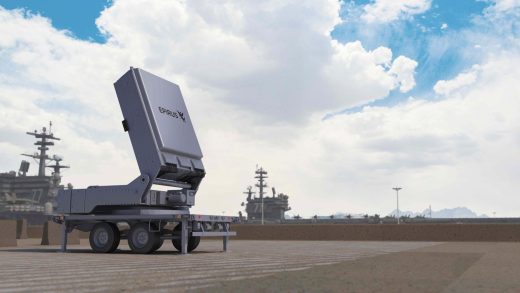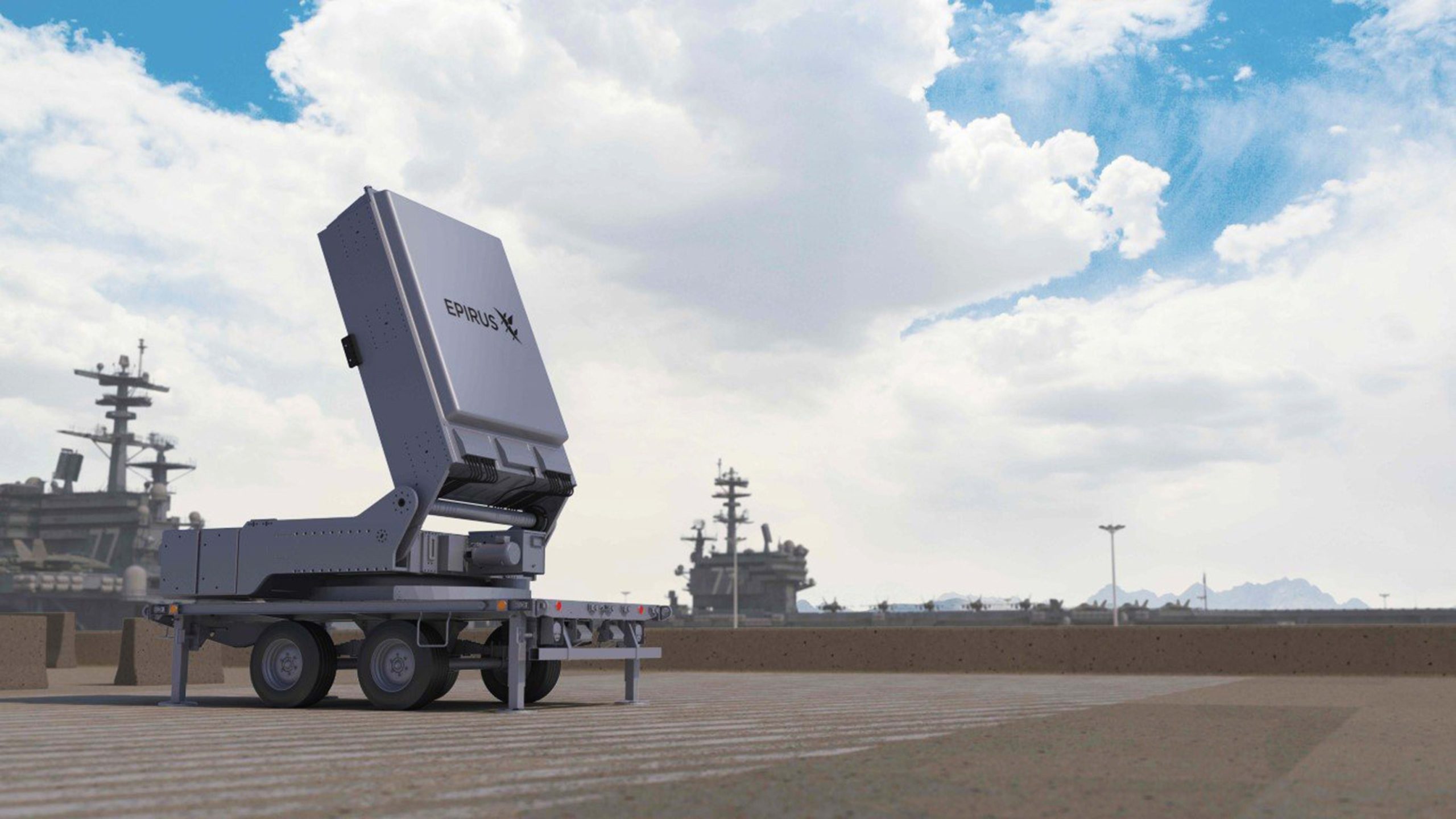Missiles, drones, and … microwaves? Introducing the Army’s latest high-tech weapon
Missiles, drones, and … microwaves? Introducing the Army’s latest high-tech weapon
The U.S. government is leaning heavily into directed-energy weapons amid a rising tide of drone and missile threats.
BY Jared Keller
The future of air defense in U.S. military operations may owe a lot to the same technology you use to heat up popcorn for a Netflix binge.
Just weeks after disclosing the deployment of high-energy laser weapons overseas, the Army has taken possession of a platoon of four “Leonidas” high-powered microwave weapons from defense contractor Epirus, the company announced in mid-May. And like their laser cousins, several of those systems are reportedly slated to undergo testing at the hands of American soldiers in the Middle East.
A high-powered microwave is a type of directed-energy weapon that generates a cone of electromagnetic interference to disable the electronics of drones and missiles. In contrast to a high-energy laser weapon, which generates a narrowly-focused beam of energy to literally burn targets out of the sky, a microwave weapon can deliver effects across a much wider area, making them more effective at engaging multiple fast-moving drones simultaneously, according to a 2023 Congressional Research Service report.
“At the moment, there aren’t any really good options for defeating large swarms of 100 or more drones that are simultaneously attacking a target,” Epirus CEO Andy Lowery tells Fast Company. “Today, we not only have a good system for short-range air defense against those types of threats, we believe we are the only effective program solution to counter large swarms.”
Indeed, the adoption of the Leonidas – which can be either towed on a trailer by a tactical vehicle or mounted on a Stryker infantry fighting vehicle – is part of a “layered defense” strategy under the Army’s Indirect Fire Protection Capability – High-Power Microwave (IFPC-HPM) program to protect U.S. troops abroad against complex groups of adversary drones, according to the service’s fiscal year 2025 budget request. The budget states that the system will be employed for “short-range defense of fixed and semi-fixed sites from Unmanned Aircraft System (UAS) swarms.”
“High-powered microwaves like the Leonidas put out a beam of energy that’s basically like a forcefield,” Shane Karp, an Epirus spokesman, tells Fast Company.
Founded in 2018 by a group of venture capitalists (including Palantir co-founder Joe Lonsdale) and technologists, Epirus was created explicitly with this counter-drone mission in mind. The company has raised nearly $300 million in funding across three rounds and was valued at more than $1.35 billion as of its Series C fundraising round in February 2022, according to Reuters. Its board of directors includes former Secretary of Defense Mark Esper and 8VC partner (and former Palantir operations director) Alex Moore.
Epirus received a $66.1 million contract last year from the Army to deliver four Leonidas prototypes for testing in fiscal year 2024. If the system is proven during that testing, the IFPC-HPM could become an official Pentagon program of record by 2027, according to Karp, setting the stage for the wider proliferation of microwave weapons across the U.S. military.
And the IFPC-HPM isn’t the only Epirus microwave weapon on the Pentagon’s radar. Karp says the company recently inked a contract to furnish the Marine Corps with a smaller version of the Leonidas, called the Expeditionary Directed Energy Counter Swarm (ExDECS) system, that can affix to the service’s new Joint Light Tactical Vehicle for convoy protection. Beyond that, the Navy plans on testing another version of the Leonidas against small boats during an at-sea technology experiment in June.
That real-world testing can’t come soon enough for U.S. military leaders facing down a rising tide of cheap, easily-weaponizable drones, the likes of which have increasingly plagued U.S. troops deployed to the Middle East and American warships in the Red Sea following the start of the Israel-Hamas war.
“The problem of asymmetric or irregular warfare,” Lowery said. “The war that’s before us, that’s here now today, is not a war of big nuclear missiles and big jets and big ships, but drones and consumer electronics, highly-networked and distributed systems. enabled systems, highly networks and distributed – and these systems are confounding the Pentagon.”
While the Pentagon has relied on expensive (and finite) missile arsenals to swat drones out of the sky, American officials have described that cost curve as unsustainable in the long run.
“We’re flipping the entire coin over on this equation” with microwave weapons, Lowery says. “Instead of saying, ‘we’re going to build 20,000 drones and meet you drone-for-drone on the battlefield’ in a drone arms race, Leonidas says that there’s actually no need for an arms race. [The system] has an infinitely deep magazine, we don’t run out of bullets; you keep sending ‘em, we’ll keep shooting ‘em down.”
That push for high-powered microwave weapons stems not only from drone threats, but growing concerns over warship vulnerabilities to anti-ship ballistic missiles like those fired by Houthi rebels in Yemen at Navy surface combatants and commercial vessels in the Red Sea in recent months. And as The War Zone notes, those fears extend to U.S. military affairs in the Indo-Pacific area of operations, where the United States and China increasingly appear on a collision course amid rising tensions in the region.
Indeed, beyond Epirus’ upcoming at-sea test, defense contractor Raytheon in December 2023 announced a three-year contract with the Navy (as well as the Air Force) to deliver high-power microwave “antenna systems” for testing. Even further down the road, the Navy’s ‘METEOR’ project seeks to integrate a microwave weapon aboard a surface warship by fiscal year 2026 to “assess the utility” of the directed-energy system for shipboard air and missile defense, according to the service’s fiscal year 2025 budget documents. (Epirus is not currently involved in that program, Karp tells Fast Company.)
According to Epirus, the rise of new drone and missile threats marks a major paradigm shift in modern warfare, where advances in the technology underpinning intelligence, surveillance, and reconnaissance capabilities have made it relatively easy to identify and target large, slow-moving platforms like aircraft carriers and other surface warships with the distributed, asymmetric threat of comparatively-cheap drones and missiles.
“You used to be able to hide from the enemy; the entire battlespace is now in play,” explains Karp. “Now it’s near impossible to get a centralized battle group in position because they’re constantly at risk of being targeted by drones and long-range missiles. We see these forces as the need for high-powered microwaves to add a layered defense against drone attacks.”
Military leaders appear to concur with Epirus’ assessment. Navy surface warfare boss Vice Adm. Brendan McClane emphasized to reporters in January that the service needed to accelerate its fielding of directed-energy weapons like lasers and microwaves to deal with the complex array of threats currently facing American warships in the region.
“What we’re facing in the Red Sea is more than just drones. We’re looking at land-attack cruise missiles, we’re looking at anti-ship ballistic missiles that are getting shot in the Red Sea by the Houthis. And our ships are dealing with all of those,” McClaine said, per DefenseScoop. “One of the things that I think we really need to get after quicker is we need to accelerate the development of directed-energy weapons, whether it’s a laser, whether it’s a microwave.”
Echoing McClane, CENTCOM chief Army Gen. Michael “Erik” Kurilla subsequently urged lawmakers during a Senate Armed Service Committee hearing in March to invest in a layered defense that includes high-powered microwave weapons to combat the threat of drone swarms rather than focusing entirely on the point defense of laser weapons.
“The bigger concern is if you start talking about swarms, so we need to continue to invest in things like high-powered microwave [sic] to be able to counter a drone swarm that is coming at you,” Kurilla said at the time.
After decades of failed attempts, the Pentagon currently has several high-powered microwave weapons in its arsenal, including the Air Force’s Tactical High-Power Operational Responder (THOR) and the classified Counter-Electronic High-Power Microwave Extended-Range Air Base Defense (CHIMERA) that’s designed to engage drones at “greater distances.” But based on the 2023 Congressional Research Service (CRS) report, none of these systems appear ready for prime time.
The “secret sauce” behind Epirus’ success, according to Karp, is a simple technology choice. Instead of using large and unwieldy magnetron vacuum tubes like those employed in the THOR system, the Leonidas system is made up of several solid-state gallium nitride semiconductor “pods” that are far more compact and generate far more power. While radar technology based on gallium nitride systems has been around for about 20 years, the technology’s application to counter-drone microwaves is a more recent development, according to Defense One.
Microwave weapons are not without weaknesses. According to the CRS report, the systems not only have a shorter range than kinetic weapons or even high-energy lasers, but can potentially “affect all unshielded electronic systems within range,” raising the prospect of electromagnetic fratricide in a combat situation in which the system accidentally fries friendly electronics.
When asked about that issue, Karp emphasized that the interference is entirely “software defined” and can be tuned to only affect frequencies on a specific wavelength. “We can precisely tun the waveform sent out in the atmosphere for ‘precision strikes’ by focusing the beam at the right frequency,” he explained. “If a unit suddenly finds itself facing a new threat, we can simply do a software upgrade to generate a new wavelength to attack the right frequencies.”
Despite Karp and Lowery’s optimism, it’s the upcoming testing of the IFPC-HPM at the hands of American soldiers in the Middle East that will determine if the Leonidas is truly ready for action in a combat zone, let alone effective enough to scale up for integration aboard a Navy warship. But with the skies above Red Sea thick with drones and missiles, one thing is clear: the Pentagon needs a cheap, effective solution when it comes to protecting U.S. troops in the line of fire – and high-powered microwaves might just get the job done.
ABOUT THE AUTHOR
(18)



